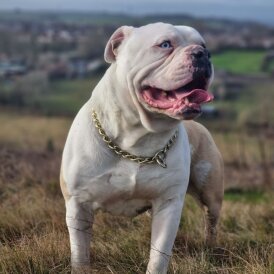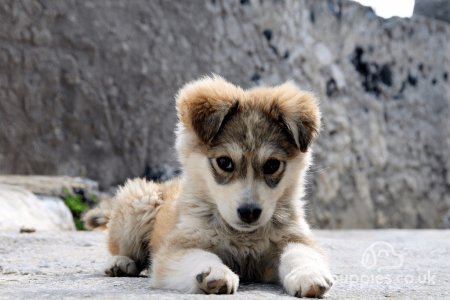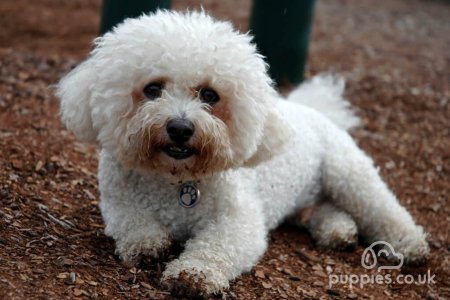Alapaha Blue Blood Bulldog (Otto Bulldog, ABBB)
Overview
The Alapaha Blue Blood Bulldog is a rare breed that was originally developed in the southern USA as a “catch dog” to drive livestock. The Alapaha is a strong, agile and affectionate family dog that needs consistent training. The Alapaha is part of the Bulldog family and is just as loyal as the American Bulldog. This well-developed, medium-sized dog is an excellent guard dog but the stubbornness and strength of the Alapaha mean they are not ideal for first-time owners.
Physical Appearance
Alapaha Blue Blood Bulldogs are medium-sized, muscular dogs with large heads, thick muzzles and strong shoulders. Alapahas are a combination of strength and agility, this athletic build makes them leaner than the Bulldog. The Alapahas head looks larger than their relatively compact frame.
The Alapahas have small drop ears that are positioned wide and high on their head. Their tails are thick at the base and taper to a point, when alert Alapahas hold their powerful tails upright. All Alapahas have short, dense fur that is smooth but stiff to touch. The Alapaha coat is white with patches of black, red, blue, merle, chocolate, fawn or brindle.
How big do Alapaha Blue Blood Bulldogs get?
Character Traits
The Alapaha Blue Blood Bulldog is protective, observant and courageous. They are a medium energy breed that needs consistent training, frequent socialising and daily walks. An Alapaha is a naturally dependable watchdog that loves spending time around their family. Alapahas don’t like to be left alone and need to be walked on a lead as they love chasing smaller animals and aren’t very friendly to strangers.
Are Alapaha Blue Blood Bulldogs intelligent? Yes, and they respond well to regular training.
Are Alapaha Blue Blood Bulldogs affectionate? Yes, but they are suspicious of strangers.
Do Alapaha Blue Blood Bulldogs have high or low energy levels? Alapahas are medium energy dogs that require daily 40-60 minute walks on lead (or in enclosed areas only).
Are Alapaha Blue Blood Bulldogs loyal? Yes, and they have a strong urge to protect their family.
Are Alapaha Blue Blood Bulldogs playful? Yes, Alapahas particularly enjoy interactive games such as fetch.
Are Alapaha Blue Blood Bulldogs aggressive? Alapahas are protective and can be aggressive as a result.
Are Alapaha Blue Blood Bulldogs easy to train? In experienced hands, Alapahas are easy to train but they can be stubborn.
Are Alapaha Blue Blood Bulldogs good guard dogs? Yes, as Alapahas were originally bred to guard and protect.
Ability to Socialise
An Alapaha Blue Blood Bulldog is excellent with children as they have a friendly, gentle nature. They will be protective of their family but may be unsure of new children so introduce them to your Alapaha carefully. Alapahas are good at socialising at home and will get on well with any pets they grow up with. When it comes to strangers, Alapahas are less tolerant so regular socialisation is important to prevent aggression.
Do Alapaha Blue Blood Bulldogs get along with other pets? Yes, Alapahas are good with pets they have grown up. Avoid interaction with smaller pets as Alapahas have a high prey drive.
Do Alapaha Blue Blood Bulldogs get along with other dogs? No, they are less tolerant of unfamiliar dogs so it is important to keep them socialised and only walk them on lead.
Are Alapaha Blue Blood Bulldogs good with kids? Yes, Alapahas are great with kids. However, they can be protective of their family so take care when interacting with children from other households.
Are Alapaha Blue Blood Bulldogs good with strangers? No, they are wary of strangers.
Lifestyle Suitability
An Alapaha Blue Blood Bulldog is best suited to living in a home with plenty of space and access to a secure outdoor area. Alapahas are powerful, agile and take it upon themselves to guard their family. They handle most temperatures well and will only bark to alert you about something suspicious. As Alapahas do not like being left alone, it is better if someone is always home.
Are Alapaha Blue Blood Bulldogs good for first-time owners? No, due to their stubborn, protective nature and high training needs, the Alapaha Blue Blood Bulldog is not ideal for first-time owners.
Are Alapaha Blue Blood Bulldogs hypoallergenic? No, as the breed sheds moderately throughout the year.
Are Alapaha Blue Blood Bulldogs prone to drooling? Unlike most other bulldogs, Alapahas do not drool.
Are Alapaha Blue Blood Bulldogs a good Alapaha Blue Blood Bulldog for apartment living? Alapahas are docile when indoors but are not recommended for an apartment as they should have access to an enclosed outdoor space.
Do Alapaha Blue Blood Bulldogs shed a lot? This breed sheds moderately all year round.
Do Alapaha Blue Blood Bulldogs bark a lot? No, Alapahas only bark when they have a reason to.
Can Alapaha Blue Blood Bulldogs be left alone at home? No, the strong bond Alapahas form with their family means they may exhibit destructive behaviours if left alone.
Can Alapaha Blue Blood Bulldogs handle the heat? Yes.
Can Alapaha Blue Blood Bulldogs handle cold temperatures? Alapahas prefer average - warm weather.
Are Alapaha Blue Blood Bulldogs sensitive to loud noises? Alapahas are not sensitive to loud noise but it is best to keep the noise down when bringing a puppy home.
General Health & Health Issues
Alapaha Blue Blood Bulldogs have an average life expectancy of 11-14 years. As the Alapaha is a rare breed they have a small gene pool and can suffer from several health issues. Regular vet checkups are recommended and Alapahas need to get daily exercise to avoid weight gain.
There are a few hereditary health issues to be aware of:
Entropion - This condition causes the eyelids to roll inwards. It can be painful and cause ulcers but can be treated.
Cherry Eye - This is the inflammation of tear ducts, you will notice a red bulge in the corner of your dog’s eye. Cherry eye can be treated.
Congenital Deafness - This genetic disease is associated with dog breeds with white coats, including Alapahas. Dogs with congenital deafness can live normal lives but breeders should never breed with dogs suffering from this condition.
Hip Dysplasia - This is common in many breeds and is when the hip and leg don’t sit right. This cause the hipbone to be malformed causing pain, reduced mobility and lameness. Physiotherapy can help dogs with hip dysplasia.
Skin Problems - Alapahas can suffer from skin problems and allergies. If you notice any skin issues then it is best to get it checked at the vets so they can recommend the best course of treatment.
How long do Alapaha Blue Blood Bulldogs live? 11-14 years
Exercise & Play Time
Alapaha Blue Blood Bulldogs are medium energy dogs, they are more than happy to relax at home with you but need a daily walk of around an hour to stay healthy. An Alapaha should always be walked on a lead because they have a high prey drive and are not particularly friendly with unknown dogs. If you enjoy running, an Alapaha would make a great running partner. To prevent boredom, Alapaha Bulldogs like to have a secure outdoor space where they can run around, play fetch and enjoy time off lead.
As an Alapaha shouldn’t be walked off lead it is best to walk them in quieter areas where there will not be too many unfamiliar dogs. An Alapaha sees their daily walks as a patrol but make sure they do not take their guarding role too seriously as this will make them overly defensive.
How much exercise does an Alapaha Blue Blood Bulldog need? 40 - 60 minutes of exercise per day. This should include time off-lead in a safe, secure area, it is important not to let an Alapaha Blue Blood Bulldog off lead in open areas as they have a high prey drive.
Do Alapaha Blue Blood Bulldogs like water play? Many Alapahas enjoy water and will swim often, especially to cool down in hot weather.
Nutrition & Feeding
Alapaha Blue Blood Bulldogs do well with high quality dry food. Any dietary changes should be made gradually to avoid digestive issues.
On average, a one year old Alapaha Blue Blood Bulldog will eat 700 - 900g of dry food each day. This food should be split into two portions. Keep in mind this is just an estimate, as each dog is different it is important to have a personal dietary plan made that is specific to your Alapaha.
Are Alapaha Blue Blood Bulldogs prone to weight gain? No, however, some Alapahas are prone to gaining weight after being spayed or neutered.
How much should I feed a Alapaha Blue Blood Bulldog puppy? A 2-6 month Alapaha puppy should be consuming 230 - 450g of good quality food each day, split into 3-4 smaller meals. A 7-12 month Alapaha puppy should be fed 300 - 950g each day. The amount you feed your Alapaha puppy depends on the puppy’s build and the nutritional value of the food being offered.
How much should I feed an adult Alapaha Blue Blood Bulldogs? An adult Alapaha Bulldog should be eating between 320 - 580g of good quality food per day depending on their weight and activity level.
Care & Maintenance
Grooming: an Alapaha has minimal grooming needs. Their short hair needs to be brushed weekly to reduce shedding. Your Alapaha Blue Blood Bulldog won’t need to be groomed by a professional but they will need their eyes and ears cleaned occasionally to help avoid infections.
Emotional Care: Alapaha Blue Blood Bulldogs love to be with their family, they are highly protective and affectionate so feel happiest when they are around their owners. Due to this, Alapahas do not like to be left alone. Alapahas are more sensitive than other dog breeds, they like routine and are highly receptive to their owner’s emotions. Alapahas like to be challenged by learning new commands and 20 minutes of behavioural training each day will help to keep your dog stimulated.
History of the Alapaha Blue Blood Bulldog
The Alapaha Blue Blood Bulldog was first documented in 1979 but there is evidence of the breed being around for 200 years in the southern part of the USA. The Alapaha is believed to be the result of breeding several bulldogs breeds including the Old English Bulldog and the Old Southern Bulldog.
At first, the Alapaha was considered a working dog and would spend their time guarding homes and driving livestock. A farmer named Buck Lane famously began a breeding program in the 1800s to keep the Alapaha Bulldog from disappearing. These days, the Alapaha is a loyal family pet that, while rare, is increasing in popularity across the UK.
Interesting Facts About Alapaha Blue Blood Bulldogs
Buck Lane famously bred Alapahas in Georgia, USA.
Buck named the breed after the Alapaha River and added “Blue Blood” as he believed they represent a noble breed.
The Alapaha was used as a “catch dog” to herd stray livestock.
The breed used to be called Otto Bulldogs, Otto, Cowdog and Silver Dollar Dogs.
Alapaha Blue Blood Bulldog was first officially documented in 1979.
Getting a Alapaha Blue Blood Bulldog Puppy
Talking to local vets and breed clubs can help you to find Alapaha Blue Blood Bulldog puppies in your area but the most common method of searching is online. You can see if there are any Alapaha Blue Blood Bulldog Puppies available in your area here.
When buying a new puppy, be aware of scammers and never send a deposit before seeing the puppy. At Puppies, we always check listings against a fraud database. This buying guide will help you to find your new puppy from a trustworthy, reputable breeder and includes a handy list of questions to ask.
How much does a Alapaha Blue Blood Bulldog cost to buy? - Roughly £1,000 to £2,000
How much does a Alapaha Blue Blood Bulldog cost to feed? - High quality food will cost £40 - £50 a month.
How much does insurance for a Alapaha Blue Blood Bulldog cost? - £55 - £135 per month depending on coverage.
Rehoming a dog through rescue and adoption is another option, talk to rescue centres in your area. While there are no UK organisations specific to the rare Alapaha Blue Blood Bulldog, these organisations and associations may be able to help in your search:
https://www.dogstrust.org.uk/rehoming/
https://www.nawt.org.uk/rehoming/dogs
https://www.rspca.org.uk/findapet/rehomeapet












